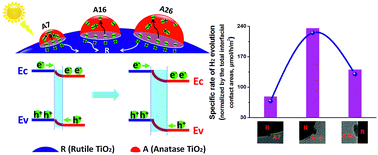Boosting photocatalytic water splitting by tuning built-in electric field at phase junction†
Abstract
Constructing a built-in electric field at the interface of semiconductors has been demonstrated to provide the driving force for spatial charge separation in photocatalysis. Although phase junctions (interfaces formed between two crystalline phases of the same semiconductor) have been demonstrated to be effective in spatial charge separation, regulation of the photocatalytic activity by precisely tuning the built-in electric fields is not yet well understood. In this work, taking anatase/rutile TiO2 phase junction as an example, the built-in electric field in the phase junction region was modulated via fabricating controllable anatase nanoparticles on rutile TiO2 surface to manipulate the interfacial contact area between anatase and rutile phases. We found that photocatalytic H2 evolution depends strongly on the interfacial contact area between anatase and rutile TiO2. The relation between the anatase/rutile phase junction interfacial contact area and the specific photocatalytic activity shows a typical volcano curve, that is, increasing the interfacial contact area results in enhancement of the driving force for spatial charge separation, allowing more electrons and holes to migrate to the surface and participate in redox reactions, but further increasing the interfacial contact area leads to decline of photocatalytic activity. The optimized interfacial contact is the most favorable balance between the strength of built-in electric field and transfer distance for photogenerated charge carriers for separation and transfer of photo-generated electrons and holes at the phase junction region. Our work provides new insight into the construction of built-in electric fields on the surface of semiconductor-based photocatalysts to boost spatial charge separation for solar energy conversion systems.



 Please wait while we load your content...
Please wait while we load your content...